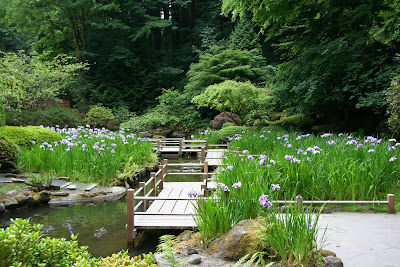I have always had a lot of container plants. Before we bought this house we rented a house for six years. I wasn’t allowed to plant anything permanent, so I had tons of potted plants on our front porch. I still keep several potted plants on the front porch and on the back steps. I also have a few in my greenhouse. Here’s some of my outdoor potted plants from this year...
First the front porch. I get a little bit of sun here, but not much. Shady plants seem to do best, such as ferns, coleus, and begonias.
 |
| Potted plants on front porch. |
This was a gorgeous double begonia. Unfortunately, it didn’t do so good while I was on vacation and doesn’t look nearly as pretty as this right now.
 |
| Double Begonia. |
This Osteospermum and Verbena were so pretty, but these didn’t last the whole summer.
 |
| The centers of the Osteospermum were purple with bits of bright orange. |
I have tried several different plants through the years in my hanging baskets and these Dragon Wing Begonias outperform any other plants I’ve tried. My fern stand is in the background.
 |
| Dragon Wing Begonia and fern stand. |
I have a few container plants on the back steps: (from top to bottom) Johnny Jump-ups which are no longer there, sedum, a red aloe, Balboa Globe Amaranthe, another much smaller variety of sedum, and one of my favorites which is my “bog’” of carnivorous plants.
 |
| Container plants on the back steps. |
I planted the carnivorous plants last year in a class I took at Longwood Gardens. It was the COOLEST garden class I have EVER taken. I learned a lot about carnivorous plants and we all got to plant our own container which has these plants in it: White Top Pitcher, Moore’s Pitcher, Purple Pitcher, Venus Flytrap, Spoonleaf Sundew, Threadleaf Sundew, Ladies Tresses, and a Rose Gentian for a bit of pink in the center (not blooming in this photo).
 |
| My “bog” container of carnivorous plants. |
Here’s a close-up of part of the “bog” container.
 |
| Purple Pitcher plant and Venus flytrap. |
I lost the tag for this one that I planted a couple of years ago, but I think it’s a type of Aloe.
 |
| Purple Aloe, I believe. |
Here’s a tiny variety of Sedum along with Balboa Globe Amaranthe.
 |
| The purple/lavender Globe Amaranthe flowers with the bits of orange are really lovely. |
I also have a container of water plants right outside the back door. This has a Pitcher plant, Dwarf Horsetail, and Star Grass.
 |
| Container of water plants near the back steps. |
I have this strawberry pot in my Kitchen Garden. I planted a variety of succulents and herbs in it, including French Tarragon, a Scented Geranium, Curry Plant, and more. The Curry Plant can’t actually be used as curry flavoring in food, but it sure does smell like it. I love rubbing my hands on the various scented plants in this pot whenever I walk by it.
 |
| Strawberry pot in the Kitchen Garden filled with succulents and herbs. |
When I was at the Philadelphia Flower Show early this year I saw a display there that included a birdhouse with a “green roof.” I looked and found a couple, however they were quite expensive. I thought I could convince Brian to build one for me. In the meantime, I found this miniature green-roof birdhouse (probably too small for birds) at Lowe’s. It actually already had the succulents planted in it. I nailed it to a stake and put it in my Kitchen Garden. Isn’t it so cute?!?!
 |
| “Green roof” miniature birdhouse in the Kitchen Garden. |
I have more container plants in my house and greenhouse. I think that will have to be another post, though.




























































